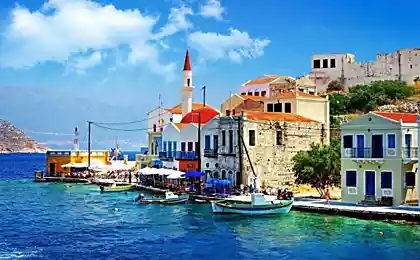278
10 most beautiful places in Spain
From the northern mountains to the hot Seville and the far Canary Islands: which places to visit to most fully embrace the splendor of sunny Spain?
1. Pueblos Blancos, Andalusia
Snow-white villages that humiliated the hilly area in central Andalusia not so long ago experienced a period of decline: young people left these farm settlements en masse, going to work in major cities. However, now the villagers clearly decided to attract more tourists and engaged in the restoration of buildings and pavement. Narrow alleys winding between snow-white houses, ancient churches and colorful platforms have regained their medieval charm. The most picturesque of the villages are Grazalema, Weher de la Frontera and Arcos de la Frontera.
2. Alhambra, Granada
The Moorish fortress covered with stunning carved patterns is one of the most visited monuments in all of Spain. The complex of palaces, surrounded by manicured gardens, crowns the top of the hill; the background is the snow-capped peaks of the Sierra Nevada mountains. Inside its walls, the fortress is no less impressive: here, among the peaceful courtyards, Moorish lush elements of decor amusingly contrast with the laconic lines of baroque elements of later eras.
3. Gaudí's masterpieces, Barcelona
The Catalan capital has no shortage of virtues: the vibrant nightlife, long beaches and expanse for shopping make it one of the most popular tourist destinations in Europe. However, its main gems are undoubtedly phantasmagoric buildings erected by the legendary Antonio Gaudí. The most visited of his creations (and, concurrently, the symbol of the city) is, of course, the still unfinished Sagrada Familia Cathedral with its carved turrets and bizarre columns. Other masterpieces of the architect, mandatory to visit – the residential house of Casa Mila, as well as the “gingerbread” houses of Park Güell.
4. Mountain beauty, Picos de Europa
Spanish landscapes are good everywhere, whether they are long sandy beaches or wide plains. But the country's most spectacular natural views are concentrated in the mountains of the Picos de Europa Natural Park. Rocky slopes, emerald green valleys and bubbling rivers make this area in northern Spain an ideal place for trekking, rafting and other outdoor activities.
5. Cathedral, Santiago de Compostela
Spain’s numerous Gothic cathedrals are an important tribute to Catholic traditions. Perhaps the most impressive of them is the community of the Cathedral in the city of Santiago de Compostela. It is a huge building covered with baroque curls, statues and stalagmites. The cathedral is also the last point in the route of many thousands of pilgrims who pass annually along the famous pilgrimage road known as the Way of St. James.
6. Teide volcano, Tenerife
To the Canary Islands from Spain you need to fly, almost two hours. The islands are located much closer to the African coast than to the European one, and their nature differs sharply from the landscapes presented in Spain. These lands of volcanic origin are covered with stepped slopes and black sands. In the center of Tenerife – the most popular of the islands – rises the powerful volcano Teide, crowned with a snow cap. Those who decide to conquer its slopes on foot will have a walk among the completely “lunar” landscapes, and from the very top there are stunning views of the Canary Islands.
7. Formentera Beaches, Balearic Islands
Almost 10 thousand kilometers of coastline and an abundance of sunlight have long turned Spain into a beach Mecca. The beaches here are very different: from humiliated sunbeds and colorful umbrellas to virgin-desert sand strips. Perhaps the most pristine (and whitest!) beaches can be found on Fortmenter, one of the Balearic Islands. You can swim to Formentera from the mainland in just a couple of hours. The most picturesque of the beaches of the island - Ses Illetes - is a curved strip of white sand, on which the ultramarine waters of the Mediterranean Sea gently splash.
8. City of Arts and Sciences, Valencia
Spain is famous for its outstanding ancient architecture, but its modern designs are no less interesting. Located in Valencia, the architectural complex “City of Arts and Sciences”, designed by the outstanding architect Santiago Calatrava, can be called the hallmark of modern Spanish architecture. Dazzlingly white buildings of bizarre shapes, the walls of which are curved at the most inconceivable angles, are impressive at any time of the day, but they are especially picturesque at night, when their outlines are emphasized by skillful illumination.
9. Square of Spain, Seville
The capital of Andalusia is full of beautiful buildings and stunning, original Spanish atmosphere. The Plaza de España, designed by local architect Anibal Gonzalez in 1929, is a colorful kaleidoscope of colorful turrets and colonnades lavishly covered with curled patterns. In the center of the square splashes a huge fountain and canals through which you can ride on rented catamarans. The place is so picturesque that it has appeared in various films, the most famous of which is the second episode of Star Wars (Attack of the Clones).
10. Old Town, Toledo
Ancient Toledo, located in the heart of Spain, until the 16th century was the capital of the country. For many centuries, Jews, Christians and Muslims lived side by side here, for which Toledo was nicknamed the “City of Three Cultures”. Narrow cobbled streets, historical buildings, architectural monuments, majestic temples and cathedrals are a must for those who want to immerse themselves in the rich history of the country.
Source: interest-planet.ru
1. Pueblos Blancos, Andalusia
Snow-white villages that humiliated the hilly area in central Andalusia not so long ago experienced a period of decline: young people left these farm settlements en masse, going to work in major cities. However, now the villagers clearly decided to attract more tourists and engaged in the restoration of buildings and pavement. Narrow alleys winding between snow-white houses, ancient churches and colorful platforms have regained their medieval charm. The most picturesque of the villages are Grazalema, Weher de la Frontera and Arcos de la Frontera.
2. Alhambra, Granada
The Moorish fortress covered with stunning carved patterns is one of the most visited monuments in all of Spain. The complex of palaces, surrounded by manicured gardens, crowns the top of the hill; the background is the snow-capped peaks of the Sierra Nevada mountains. Inside its walls, the fortress is no less impressive: here, among the peaceful courtyards, Moorish lush elements of decor amusingly contrast with the laconic lines of baroque elements of later eras.
3. Gaudí's masterpieces, Barcelona
The Catalan capital has no shortage of virtues: the vibrant nightlife, long beaches and expanse for shopping make it one of the most popular tourist destinations in Europe. However, its main gems are undoubtedly phantasmagoric buildings erected by the legendary Antonio Gaudí. The most visited of his creations (and, concurrently, the symbol of the city) is, of course, the still unfinished Sagrada Familia Cathedral with its carved turrets and bizarre columns. Other masterpieces of the architect, mandatory to visit – the residential house of Casa Mila, as well as the “gingerbread” houses of Park Güell.
4. Mountain beauty, Picos de Europa
Spanish landscapes are good everywhere, whether they are long sandy beaches or wide plains. But the country's most spectacular natural views are concentrated in the mountains of the Picos de Europa Natural Park. Rocky slopes, emerald green valleys and bubbling rivers make this area in northern Spain an ideal place for trekking, rafting and other outdoor activities.
5. Cathedral, Santiago de Compostela
Spain’s numerous Gothic cathedrals are an important tribute to Catholic traditions. Perhaps the most impressive of them is the community of the Cathedral in the city of Santiago de Compostela. It is a huge building covered with baroque curls, statues and stalagmites. The cathedral is also the last point in the route of many thousands of pilgrims who pass annually along the famous pilgrimage road known as the Way of St. James.
6. Teide volcano, Tenerife
To the Canary Islands from Spain you need to fly, almost two hours. The islands are located much closer to the African coast than to the European one, and their nature differs sharply from the landscapes presented in Spain. These lands of volcanic origin are covered with stepped slopes and black sands. In the center of Tenerife – the most popular of the islands – rises the powerful volcano Teide, crowned with a snow cap. Those who decide to conquer its slopes on foot will have a walk among the completely “lunar” landscapes, and from the very top there are stunning views of the Canary Islands.
7. Formentera Beaches, Balearic Islands
Almost 10 thousand kilometers of coastline and an abundance of sunlight have long turned Spain into a beach Mecca. The beaches here are very different: from humiliated sunbeds and colorful umbrellas to virgin-desert sand strips. Perhaps the most pristine (and whitest!) beaches can be found on Fortmenter, one of the Balearic Islands. You can swim to Formentera from the mainland in just a couple of hours. The most picturesque of the beaches of the island - Ses Illetes - is a curved strip of white sand, on which the ultramarine waters of the Mediterranean Sea gently splash.
8. City of Arts and Sciences, Valencia
Spain is famous for its outstanding ancient architecture, but its modern designs are no less interesting. Located in Valencia, the architectural complex “City of Arts and Sciences”, designed by the outstanding architect Santiago Calatrava, can be called the hallmark of modern Spanish architecture. Dazzlingly white buildings of bizarre shapes, the walls of which are curved at the most inconceivable angles, are impressive at any time of the day, but they are especially picturesque at night, when their outlines are emphasized by skillful illumination.
9. Square of Spain, Seville
The capital of Andalusia is full of beautiful buildings and stunning, original Spanish atmosphere. The Plaza de España, designed by local architect Anibal Gonzalez in 1929, is a colorful kaleidoscope of colorful turrets and colonnades lavishly covered with curled patterns. In the center of the square splashes a huge fountain and canals through which you can ride on rented catamarans. The place is so picturesque that it has appeared in various films, the most famous of which is the second episode of Star Wars (Attack of the Clones).
10. Old Town, Toledo
Ancient Toledo, located in the heart of Spain, until the 16th century was the capital of the country. For many centuries, Jews, Christians and Muslims lived side by side here, for which Toledo was nicknamed the “City of Three Cultures”. Narrow cobbled streets, historical buildings, architectural monuments, majestic temples and cathedrals are a must for those who want to immerse themselves in the rich history of the country.
Source: interest-planet.ru






















